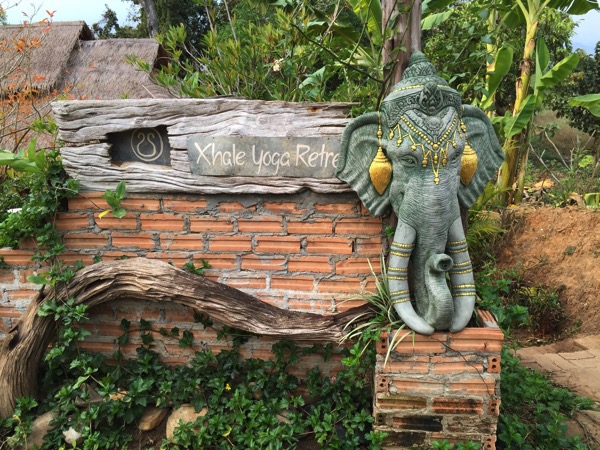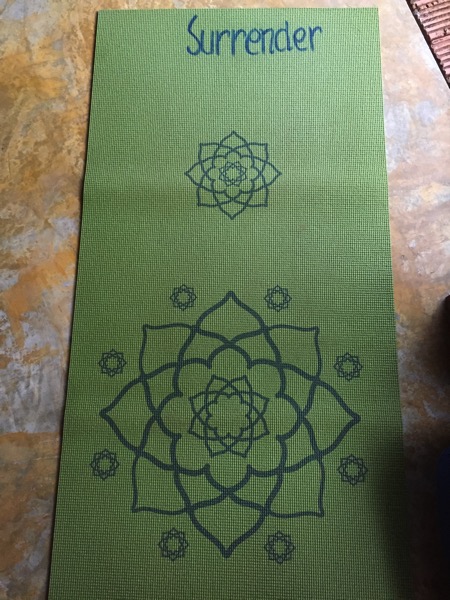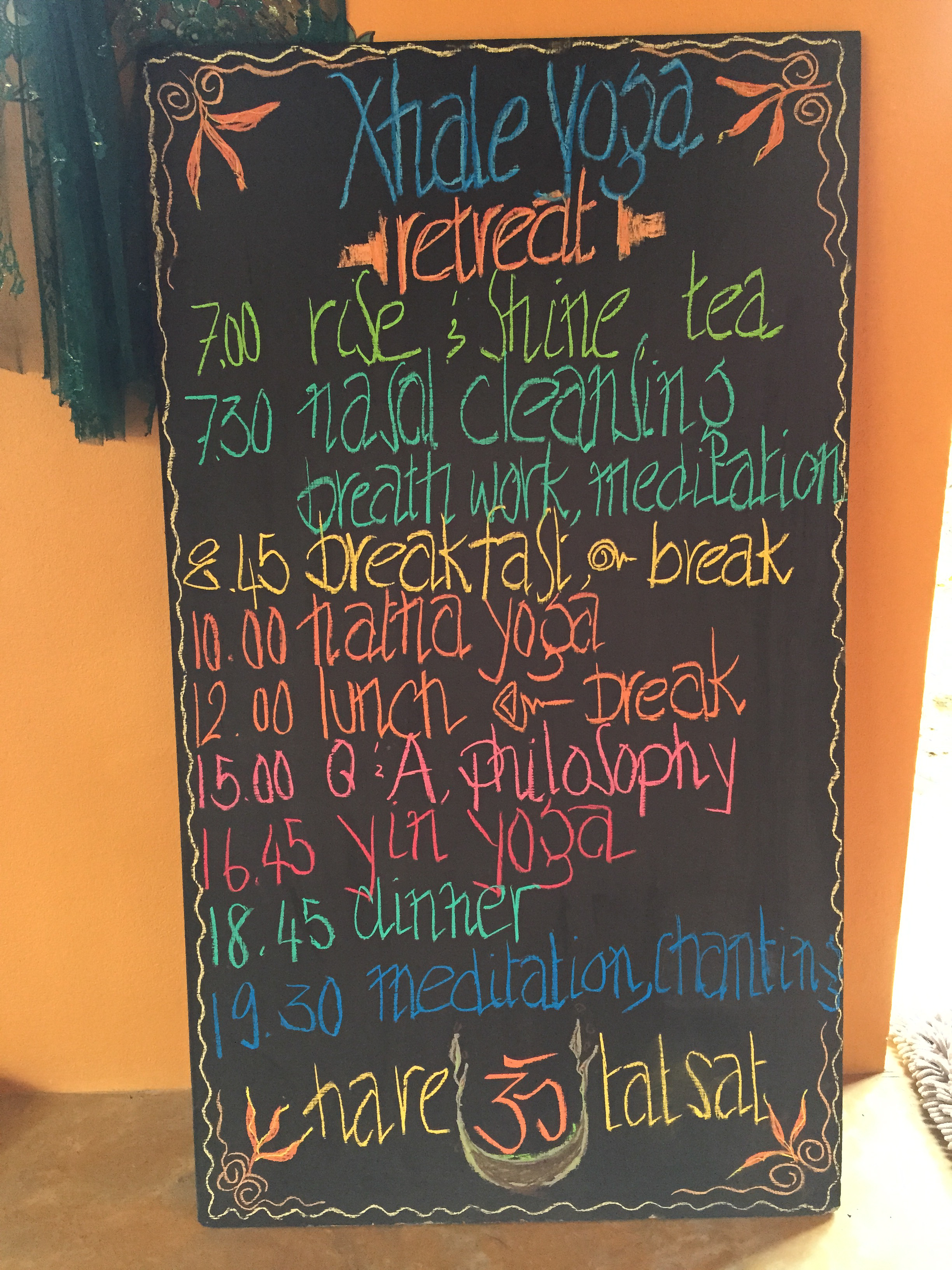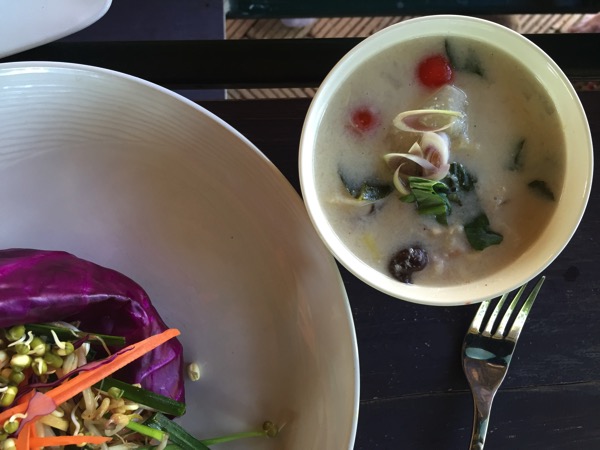Surrender

My 2015 began in Pai, Thailand at the Xhale Yoga Retreat.
This was my first yoga retreat. I’ve attended five previous retreats, one for each of the years I spent at a private Jesuit high school. Yearly retreats were part of the curriculum there and part of the Jesuit rule. I don’t remember them very well except as extended field trips, a way to relieve the boredom of class routine. They’re a habit that didn’t stick.

Recently I’ve (re)discovered yoga. A retreat seemed like the perfect opportunity to learn more and practice more deeply that a series of 60 or 90 minute classes allow. And then this black flyer appeared at my guesthouse in Chiang Mai, promising a yoga retreat in Pai, which I was planning to visit anyway.
You don’t ignore signs like that. Obviously I had to go.
Initiation
After being collected from the Pai bus station by a song theaw we were whisked off to the resort. The accommodations were a private bungalow with en-suite shower. Plusher than I need — or indeed than I’m used to these days. After settling in, Bhud, our teacher for the week, arrived. We all walked over to our home for the next few days: the Xhale studio, lounge and dining area.
Bhud is a tiny, energetic woman brimming with enthusiasm. I’d assumed the name Bhud was one of those eponyms that yoga people sometimes take on. A sanskit nickname. It is a nickname, but it’s an original shortening of her full Thai name.
Bhud is the teacher, there’s no other support staff except for the chefs. In the west she might have been a hippy or an artist. She’s much more concerned with experimentation and experience than with hard rules and precise explanations. But a type A hippy: one with a drive to make everything perfect.
Her openness is infectious and a great motivation to simply do what you feel like doing rather than to overthink things. In this sense she’s the opposite of my normal nature, which made this the experience I needed and not the one I was expecting.
And notice the subtle trick she plays when she tells you to do what you feel like: you first have to know what you feel. It’s a great ploy to keep you self-aware. That awareness is so easily lost when following precise directions.

Surrender
She explained some basics over refreshing chilled coconuts. We were each given a neti pot, a water bottle, a yoga mat — each identified by our retreat nickname. The nicknames were selected at random, and included “Kindness”, “Meditative”, etc…
Mine was “Surrender”.
This is exactly what I’m seeking these days, on this trip. These meaningful little coincidences happen all the time now like the comforting sights of signposts along an unfamiliar road.

Schedule
I’ve been without a daily schedule for months now. Nevertheless it was easy to fall into the daily routine of the retreat. It was especially easy since all the activities took place at the outdoor studio and adjacent kitchen/dining area. Just show up at 7 am, then again after the break at 3 pm. And since we were outside of town with no transportation, there wasn’t much to do to distract your from your appointments.
That said, the schedule was packed. It went from 7 am until about 9 pm with only a break from 12 pm to 3 pm during which we ate lunch and a few other small slivers of time. So it was a little over 2 hours of free time during the day and when the night came around I was typically too exhausted to do anything much other than shower and get ready for sleep.
Silence
The days began with silence until noon. This new experience was easy for me and kind of wonderful: it’s easier to be in the moment when you don’t need to plan what to say, to make conversation. Especially while eating, it was very pleasant simply to focus on the food.
The idea extended beyond talking during the prescribed time. Reading fiction was discouraged. Don’t get involved in stories. I turned off email and Facebook and other ways of letting my mind run away from the present experience. This really helped and made the retreat especially intense.
Food
“You might not get as much as you want, but you’ll get what you need.”
These were the ominous words Bhud spoke during our introduction concerning the portion sizes. I was already a little nervous about the vegetarian meal plan. The anxiety had powered a bunch of silly jokes in the weeks preceding the retreat. It’s likely that I haven’t gone so long without eating meat since I was a child, perhaps even since I was a baby. Add to that her mentioning that dairy would not be included — nor, it turns out, eggs except for 1 quarter hard boiled egg and slivers of omelette with a couple of meals meal — and my apprehension grew.
Also, Bhud is a strong believer in minimal processing. Raw is better than steamed which is better than boiled which is better than stir fried which is better than deep fried. So, salad for every meal? Perpetually unsatisfied hunger? Would I roam the countryside farms looking for untended chickens to steal? (See, that kind of silly joke)

I needn’t have worried. The portions were not that small and they were supplemented by abundant fruit and honied tea. Lunch was the largest meal of the day and that caused some disappointing evening meals before I cottoned on to the pattern. But it was more than enough food. The few ‘free’ plates left by those who got ill or didn’t want them were not tempting. And I was not alone: they typically went unclaimed.
<img style=”display:inline; float: left; width:20em; padding:.5em;”src=”http://www.thecastawaylife.com/blog/wp-content/uploads/2015/01/yoga-chefs-jpg.jpg” alt=”Our amazing chefs” title=”chefs-jpg.jpg” />Even better, the food itself was fantastic. The chef, Tuttu, and the sous-chefs were amazing. They could be heard working away all day long to prepare the 3 meals and smoothies from scratch. Each prepared with fresh, organic ingredients. Fantastic flavors, perfectly prepared in an astonishing variety. A warm beetroot soup here, a veggie pad thai there. Roasted vegetables with a sprinkling of nuts. A tom kha soup with mushrooms.

And then, surprise. We got to make our own fresh rolls for lunch one day. The chefs had done the hard work of chopping the veggies, preparing the salad, making the tofu and omelette strips. We just had to hydrate the rice paper, fill it up and enjoy. And so we did.
What difference did giving up meat make? It wasn’t very difficult. Surprisingly not. Nor was it some kind of revelation of a new frontier of health. I felt neither much worse nor much better. No lack of energy nor abundance of energy. This makes me feel good; like my body is simply adaptable and not dependent on one kind of nutrition.
The most peculiar part of the schedule which was the short time between the beginning of breakfast at 8:45 and the hatha yoga at 10. This challenge was solved elegantly with breakfasts of soups and smoothies. Healthy smoothies. Ones which also worked very well as palate cleansers.<aside class="notice"> On leaving the retreat, I decided I’d keep refraining from meat until my body asked for it. Not a craving in the mind, but a real feeling in the body. I intended this to help me be more mindful. As I write this, it’s four days after the retreat and I haven’t felt the need.
</aside>
Asana Yoga
When I write “yoga”, the asanas are the part most people know about. The poses. Downward dogs and tree poses. That was certainly the extent of my knowledge before I attended the retreat.
But there’s much more to to yoga — 7 more limbs in fact — as follows in the sections below, but there was a lot of asana yoga: two hours each daily reserved for hatha yoga practice and yin yoga practice.
Hatha
The core of the hatha practice were the sun salutation and warrior sequences. These we practiced in the same order for many cycles every day. It was very different from my usual classes where the teachers alter the order of the poses each class, presumably to keep things fresh.
It was anything but repetitive. Instead of varying the postures themselves, Bhud changed how we’d move between the postures. Subtleties of breath. Wild experimentation with moving your limbs in any way you felt like as you moved. Varying the speed of the flow. All this freedom and change on top of a common structure was an exciting departure. It enabled me to commit the flow my memory to concentrate on the other details. And now I feel more capable of doing solo yoga, without a class or a video or an app; the movements are now automatic.
Bhud’s main emphasis in all this, received from her 2nd generation Iyengar teacher, is the spine. Focusing on the spine and its posture and movement, and those of the hips and chest at both ends as the primary concern. Then moving out to the elbows and knees and finally to the extremities. Like a starfish she kept saying. Keep the limbs light. Don’t push. The limbs are free to move when the spine is moving correctly. And the beginning of every movement is to free the spine.
This approach was new to me, and I liked it. Perhaps it was her continuous repetition, but the limbs did feel lighter when I moved like this. Less tension in the arms and the legs and more fluidity.
Yin
I admit it. I’d thought yin yoga was yoga for people who didn’t want to be challenged. Who just wanted to lie around. Boy was that wrong. The yin yoga we practiced was the most challenging aspect of the whole retreat for me. Positions were held for 5 minutes, and for certain postures — like the lunge — the pain was significant. All to stretch the ligaments. It’s hard to say just how much change in the tissues happened in these 5 days, but certainly all my Hatha flows became much more fluid. Especially after the first day, even walking felt more flowing and connected.
“Two more deep breaths” was the phrase we all waited desperately to hear, the signal that this torment was almost over. Often it was just a temporary reprieve and we’d have to do the other side of the body for symmetrical poses. The ordeal went on for almost two hours. By the end, relaxation pose then dinner were a profound relief.
If you can measure effectiveness by pain, this was by far the most effective training I undertook during the retreat.
Pranayama Yoga
Breathing exercises are typically covered very lightly in the yoga classes I’ve attended when they’re covered at all. So it was a new experience to concentrate on them.
We started by learning the “cleansing breath”. Bhud didn’t seem to be fond of using the sanskrit names, but it seems like this must have been Kapalabhati. This is where you use your diaphragm to expel the air from your lungs quickly, then relax the belly to refill them. We’d do this at two speeds: fast and slow. It definitely became easier as the days progressed to perform this exercise. It took practice to find the rhythm and feel.
Next there was alternate lung breathing. I write lung here purposefully: Bhud downplayed to the point of optionality any focus on the nostrils. Subsequent research seems to show me that this is really unusual. In any event, we’d inhale into one lung and exhale from the other, then alternate. It definitely seemed I like I could really do this, inflate one lung at a time. Perhaps I was fooling myself and I was just moving my chest. Or perhaps that’s just the same thing. These breathing exercises are really tricky like that. So I’m still a bit puzzled; if this is the same as alternate nostril breathing, why this change in technique?
Next, Budh added Uddiyan Bandha early in the second day, and directed us to practice it upon waking. It’s a bent-over stomach sucking.
Finally, we added Ujjayi breath and Bee breath (evidently Bharamari) practice.
I’m not sure I feel very strongly about these exercises. They were not hard to perform. They didn’t hurt. But neither could I feel any changes as a result, either positive or negative. Something to explore further I suppose.
Philosophy
Each day there were 90 minute philosophy sessions covering the [8 limbs][8limbs] of yoga. Bhud’s perspective was very clear: living a chemical-free organic, preferably vegetarian lifestyle avoids self harm. Her view is very much motivated by her bout with cancer, and her deep belief that it was her chosen lifestyle that fed its growth. This viewpoint is without a doubt familiar to her mostly western-European class. Regardless, it gave me an amazing impression that this is a small world to hear the same words coming from this Thai lady as I might from anyone down at a local yoga studio back home.
Much of the yoga ethics are familiar to me from my readings in Buddhism. They rhyme at least. The only topic that caused some confusion amongst us westerners was the concept that removing suffering might be the highest goal: after all, if you remove the pain, don’t you remove the pleasure? It was a great discussion.
Overall the philosophy was interesting, especially Bhud’s strong personal views on them. As a guide to organize your life, you could do a lot worse than the 8 limbs.
Meditation
Unlike the Yoga philosophy and the Pranayama, meditation is something with which I do have experience. Not experience like this though.
Mindfulness
We started with fairly straightforward mindfulness/Vipassana sitting. It was surprising to see new meditators thrown into the deep end with 30 minutes to begin with, but everyone seemed to adapt. It was very nice to have support and structure for meditation for the first time. It actually was easier in a group, just knowing everyone else was there.
Then we left my comfort zone.
Chanting
Singing is simply not something I do. I’m not against it. I just never seek it out, and it never seeks me out. It was surprising therefore to find myself chanting “Shiva Shiva Shamboo” with abandon and with hardly any trepidation. And bouncing a bit on my cushion as I did so, moving to the rhythm. It’s easy in a crowd: easy to think no one can hear you and you can just let your voice out. And it feels so good. It’s hard to think too much when your singing, and that’s a nice relief from the constant thinking to which I’m prone.
Music
Chanting was expected, it was on the brochure. The next meditation was very much unexpected.
Meditation to music. Sitting as usual, Bhud played some electronica for us during the meditation.
The combination seems bizarre: a dozen people sitting on cushions in meditation poses listening to dance music. But it worked. It worked astonishingly well. It was easier to focus and to concentrate. It was hard not to move, so I moved — inasmuch as it was possible to move while seated. My mind was quiet, relaxed and focused. Others reported colours and memories. After the music ended the sitting continued but the calm concentration remained.
It was wonderful.
Dancing
Already warmed up with music, the experiment went even further the next day when Bhud added movement to the music. The lesson was to simply let go as she played a variety of pieces — again, mostly electronic — meant to symbolize the 4 elements, water, fire, earth and air.
It should have been ridiculous. It wasn’t. By this point in the retreat, there was no fear of judgement and I just moved. And it was liberating. And so did most everyone else. Again I felt my mind surprisingly calm and concentrated too, just like real meditation.
Of course that’s the lesson: it is real meditation. Perhaps all life is if you can let go enough.
The People
The most important aspect of the retreat was the people. What a paradox to retreat from the world to find other people.
Our group was not as diverse as I’d expected. The majority were European. The most popular nationalities were the 4 Dutch, 4 Canadians (counting me). One Thai and one Chinese to represent all of Asia and one American was there to round out North America. Ages ran the gamut from 20s to 60s. Experience ranged from none to a yoga teacher with a 500 hour certification. There were a few long term travelers like myself (like the amazing couple from Montreal on an 18 month round-the-world trip), but most were holidayers. Though these being European holidays, one Irish woman was out as much as 9 weeks.
A retreat is not a leader lecturing the group so much as an ad hoc community, created from strangers, moving through a series of experiences designed for learning. A leader can’t dictate all the experiences, and everyone teaches and encourages everyone else to some extent. At least to the extent the community gels.
And our community really did gel. With half the day in silence it wasn’t all verbal, but slowly everyone became more comfortable, more loose. With most everyone pushed outside of their comfort zone and without the structure of routines and habits, the barriers melted easily. And of course a trip to a hot spring resort didn’t hurt the process one bit.
The rule of silence except for questions in the practice hall was a vague memory by the end of the retreat, replaced with relaxed joking. After the retreat, the steadily dwindling set of us still in Pai met for dinner and drinks for the next few days.
We failed that test of letting go.
The community aspect was not something I’d thought much about before attending. It turned out to be a vital component, setting it far outside the yoga class experience. It was truly touching.
What I Learned
- Put the most possible time between your neti pot nasal cleansing and the breathing exercises. Drainage is an issue. You want it to happen slowly where it can be mopped up discreetly rather than explosively in public
- Move first with the spine
- Meat is not something I need every meal. Or even every day
- Move hierarchically: from the spine to the elbows and knees to the extremities. Move the chest first, then the elbow follows. The hips first then the knees and feet follow
- Undo undo undo. The form is perfect not when you’ve added the last movement, but when you’ve removed the last unnecessary tension
- Be free. Let go of constraints you impose on yourself. Keep removing things. Surrender. The experimentation of moving through the asanas with your limbs deciding how they want to move. The experiments with meditating to music and dance
Most importantly, I learned that this kind of retreat is something I enjoy deeply. In the cliché of the milieu I want to deepen my practice. It’s something I want to do more of, and I’m seriously considering taking yoga teacher training at some point down the road.
What’s Next
One of Budh’s constant refrains was that information is useless if it’s not turned into knowledge, and knowledge is useless if you don’t experiment with it and experiments are useless if they aren’t incorporated into your life.
I’ve thought about this a lot since the retreat ended. This is a great diagnosis of the me that started this trip: I stuff a lot of facts and reading into the ‘information’ and ‘knowledge’ end of the pipeline, but not enough makes it through to change my life. Not in fundamental ways.
But that’s changing. Now I live more and think less, undoing the unhelpful overthinking. Slowly and with backsliding. But inexorably.
And this retreat is another one of those stepping stones along that path. Just the right thing at just the right time showed up along the way. No need to push these experiences to happen. Just keep walking and enjoy the movement of my body and the sun on my face and let go.
Let go and surrender.